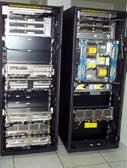UC Irvine Extends Climate Research With IBM Supercomputer
- By Charlie Zender
- 06/29/04
 Scientists around the world study the impact of human influences, such as global
warming and pollution, on natural climate cycles such as El Niño, polar-ice
movement and chemical cycles. Earlier this year, researchers at the University
of California-Irvine received a grant to invest in technology that would allow
them to predict the climate, climate changes, and climate extremes that will
affect Earth’s inhabitants in future decades. The university chose a powerful
new IBM supercomputer, the Earth System Modeling Facility (described below),
to simulate the effects of global warming, pollution and other climate stresses
for up to three hundred years in the future.
Scientists around the world study the impact of human influences, such as global
warming and pollution, on natural climate cycles such as El Niño, polar-ice
movement and chemical cycles. Earlier this year, researchers at the University
of California-Irvine received a grant to invest in technology that would allow
them to predict the climate, climate changes, and climate extremes that will
affect Earth’s inhabitants in future decades. The university chose a powerful
new IBM supercomputer, the Earth System Modeling Facility (described below),
to simulate the effects of global warming, pollution and other climate stresses
for up to three hundred years in the future.
Earth’s weather and climate result from an intricate and complex interplay
of physical, chemical, and biological processes of the atmosphere, oceans, and
land surface. The global environment that supports life on Earth absolutely
depends on the coupling of these Earth system components. This linking across
ocean/land/atmosphere places significant constraints on the architecture of
computers being able to solve the problem efficiently. It’s important
to predict future climate well enough in advance to understand now how best
to mitigate environmental changes that may have potentially adverse, even disastrous,
effects on the planet and its living organisms.
In fact, growing evidence suggests the ocean-atmosphere system that controls
the world’s climate can lurch from one state to another in less than a
decade—like a can'e that’s gradually tilted until suddenly it flips
over. Although it’s still uncertain how close we are to the threshold,
abrupt climate change may occur in the near future, possibly overwhelming many
societies with the need to rapidly adapt, and upsetting the geopolitical balance
of power.
Climatologists at UC Irvine have been using computer simulations to track the
environmental effects of phenomena like increasing fossil-fuel emissions, aerosols,
and disappearing sea ice for many years. This complex research was always done
through national supercomputing centers such as the San Diego Supercomputing
Center. But with the emergence of more innovative technology applications and
newer simulation capabilities, we realized that having our own dedicated supercomputer
would dramatically increase the quality and scale of research conducted by our
department.
Our new computer system, the Earth System Modeling Facility (ESMF), gives us
the freedom to attempt more ambitious computing projects with an almost endless
number of variables, including well-known factors, man-made pollutants such
as car exhaust, and more obscure influences, such as volcanic disturbances and
underwater ecosystems.
How It Works
The supercomputer consists of seven IBM eServer p655 AIX-based systems, each
with eight POWER4+ microprocessors connected by IBM’s clustering technology—and
one IBM eServer p690 system with thirty-two POWER4+ microprocessors. This infrastructure
delivers a freeze-frame of the changing world of high-performance technical
computing and is designed to provide the sustained compute capability, speed,
and storage capacity necessary to understand and predict atmospheric interactions
with the Earth. The supercomputer allows us to pursue data-intensive research
involving large geophysical data sets from current and next-generation numerical
models and satellite observations.
First Discovery
Our first project involves the emission and long-range transport of mineral
aerosols. We used the ESMF to probe the physical causes and biogeochemical and
climate consequences of large desert dust particles, and found a huge discrepancy
between previous simulations, which underestimated the abundance of these particles,
and our observations. Remote regions such as the Southern Ocean near the Antarctic
may receive inputs of dust-borne nutrients like iron much less regularly, and
in much larger-sized particles, than currently thought.
The ESMF makes possible new simulations that will include the complex, time-consuming,
physical processes we have shown are responsible for greater emissions of large
desert dust particles. We will soon run new, coupled simulations, which address
the previous biases of dust on climate and biogeochemistry. These will have
fewer surfaces cooling, more atmospheric heating, and more variable dust fertilization
of ocean biogeochemistry than current models.
Our improved dust distributions will strengthen radiative feedbacks in dust
source regions and weaken them afar. We believe these results will show that
dust is more capable of drying out arid regions, and generating more dust than
previously thought.